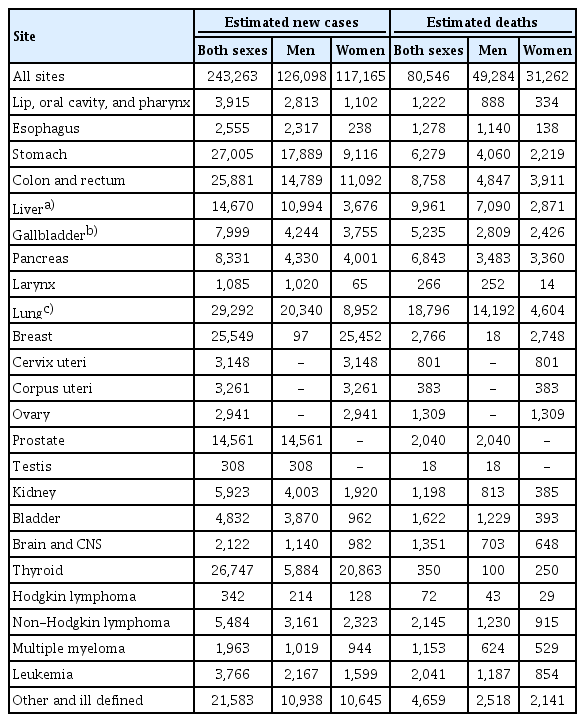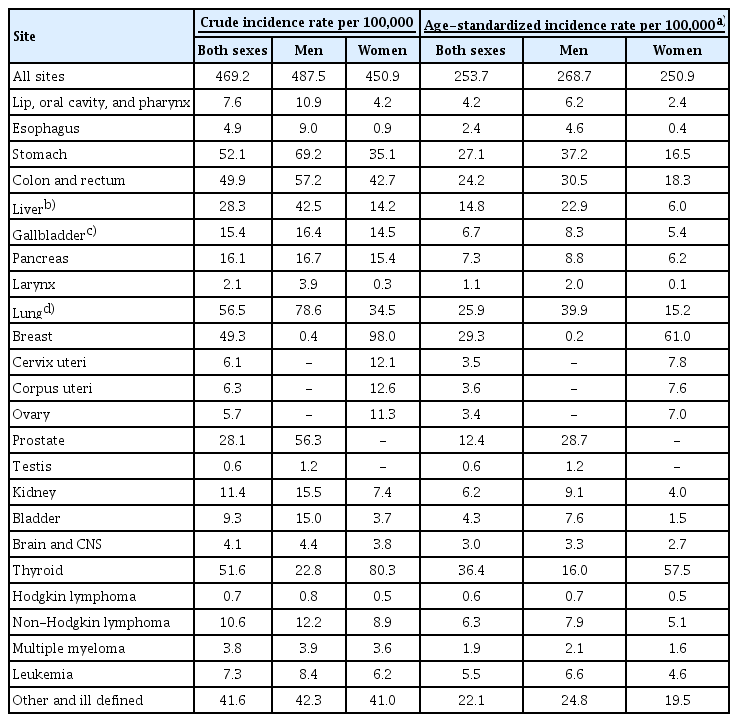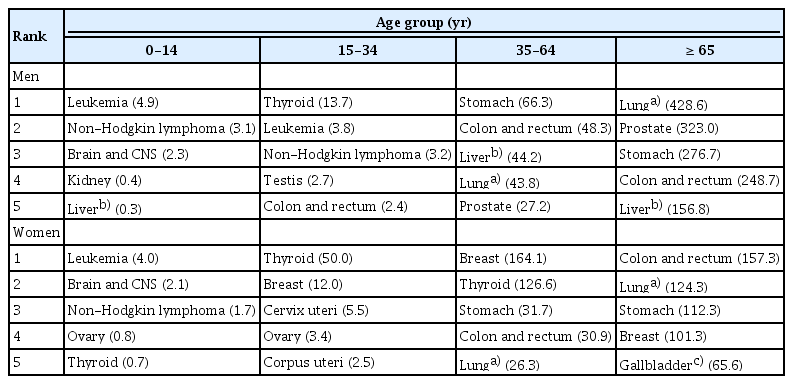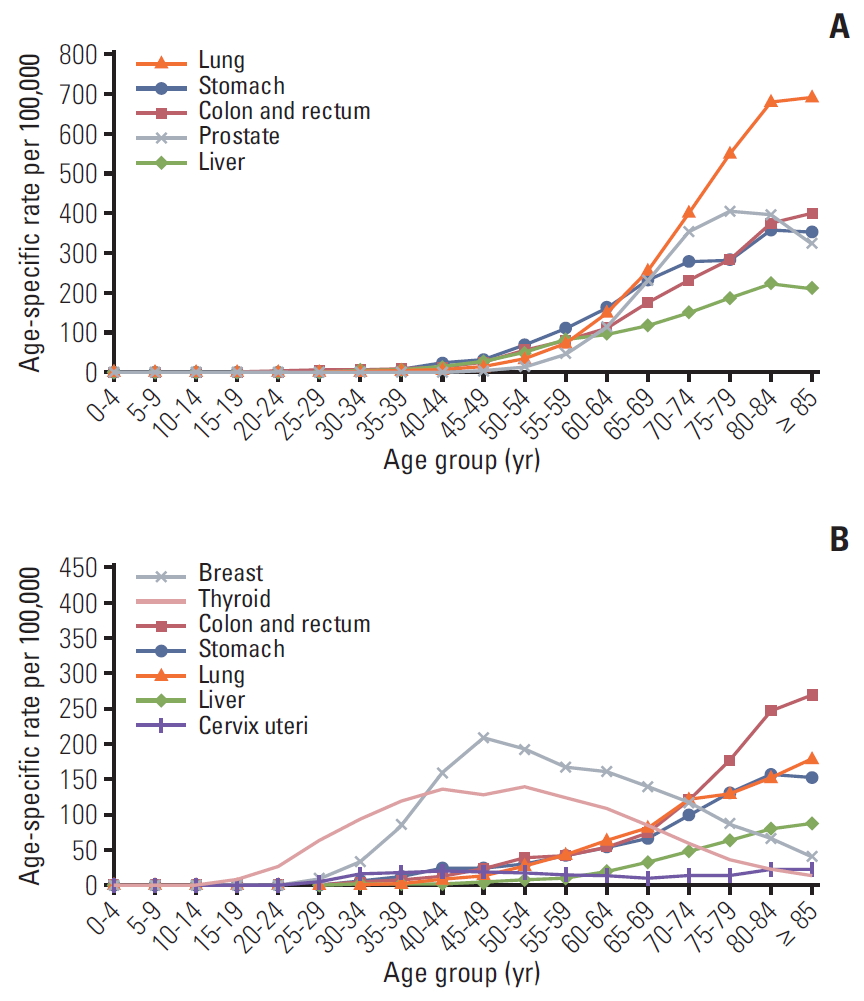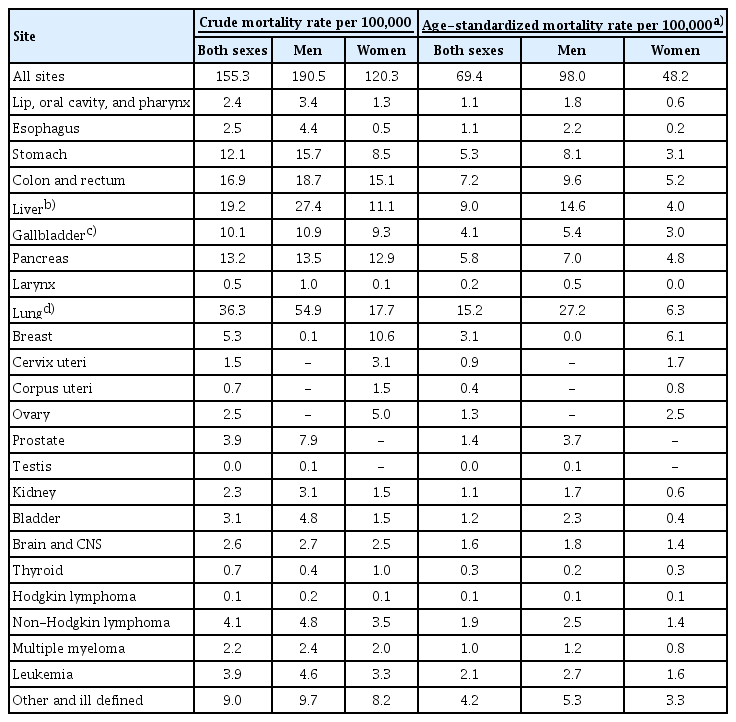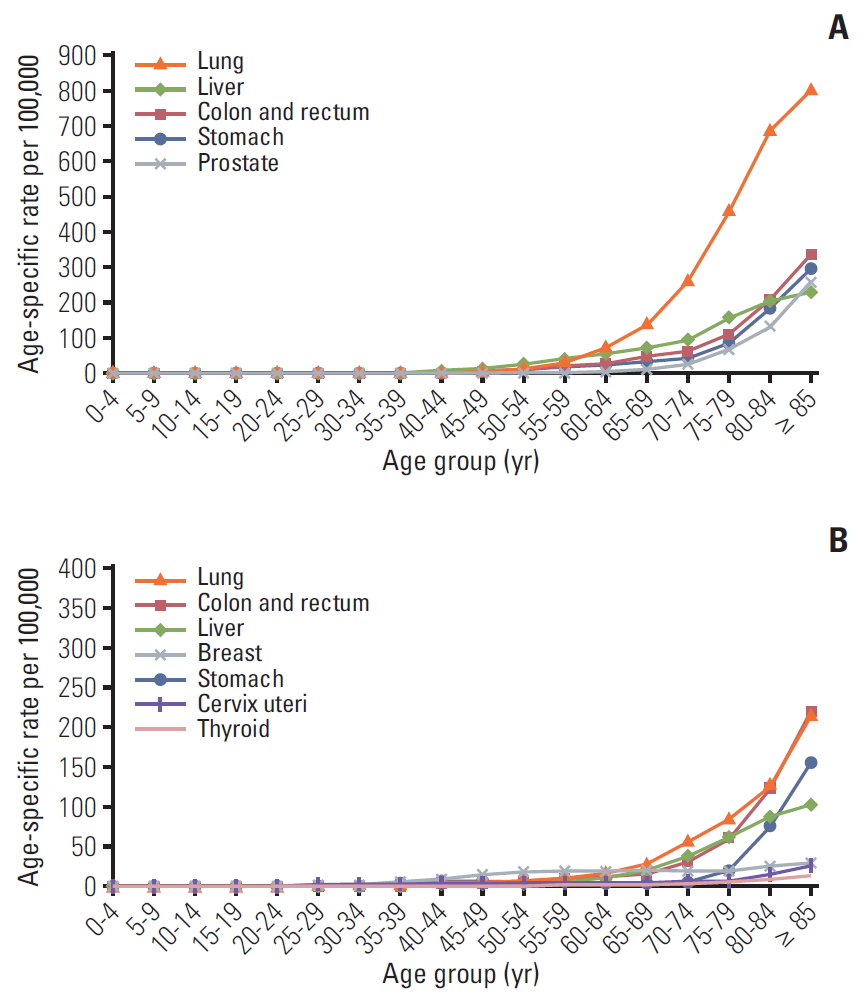Prediction of Cancer Incidence and Mortality in Korea, 2020
Article information
Abstract
Purpose
This study aimed to report the projected cancer incidence and mortality for the year 2020 to estimate Korea’s current cancer burden.
Materials and Methods
Cancer incidence data from 1999 to 2017 were obtained from the Korea National Cancer Incidence Database, and cancer mortality data from 1993 to 2018 were acquired from Statistics Korea. Cancer incidence and mortality were projected by fitting a linear regression model to observed age-specific cancer rates against observed years and then by multiplying the projected age-specific rates by the age-specific population. A Joinpoint regression model was used to determine the year in which the linear trend changed significantly; we only used the data of the latest trend.
Results
In total, 243,263 new cancer cases and 80,546 cancer deaths are expected to occur in Korea in 2020. The most common cancer site is expected to be the lung, followed by the stomach, thyroid, colon/rectum, and breast. These five cancers types are expected to represent half of the overall burden of cancer in Korea. The most common type of cancer among people who die is expected to be lung cancer, followed by liver, colon/rectal, pancreatic, and stomach cancers.
Conclusion
The incidence rates for all types of cancer in Korea are estimated to decrease gradually. These up-to-date estimates of the cancer burden in Korea could be an important resource for planning and evaluating cancer-control programs.
Introduction
As the leading cause of death in Korea [1], cancer has been a major public health concern in the country since 1983. In 2016, over 220,000 patients were newly diagnosed with cancer in Korea, and one-fourth of deaths were due to cancer [2]. Although the cancer registration system in Korea is highly efficient and can provide nationwide cancer statistics within a relatively short period, a lag time of at least 2 years is required to collect and analyze data for a specific year. For planning and implementing comprehensive cancer-control programs, it is important to assess the number of new cases and deaths that are expected to occur during the current year. In this study, we report the projected cancer incidence and mortality for the year 2020 based on data from the 1990s to 2018.
Materials and Methods
The Korean Ministry of Health and Welfare initiated a nationwide, hospital-based cancer registry, known as the Korea Central Cancer Registry (KCCR), in 1980. The history, objectives, and activities of the KCCR have been documented in detail elsewhere [3]. Cancer incidence data from 1999 to 2017 were obtained from the Korea National Cancer Incidence Database (KNCI DB). Cancer cases were classified according to the International Classification of Diseases for Oncology, 3rd edition [4] and converted according to the International Classification of Diseases, 10th edition (ICD-10) [5]. Mortality data from 1993 to 2018 were acquired from Statistics Korea [1]. The cause of death was coded and classified according to the ICD-10 code [5].
The cancer sites included in this study were (1) all cancers sites combined and (2) the 24 most common cancer sites as follows: lips, oral cavity, and pharynx (C00-C14); esophagus (C15); stomach (C16); colon and rectum (C18-C20); liver (C22); gallbladder, etc. (C23-C24); pancreas (C25); larynx (C32); lung (C33-C34); breast (C50); cervix uteri (C53); corpus uteri (C54); ovary (C56); prostate (C61); testis (C62); kidney (C64); bladder (C67); brain and central nervous system (C70-C72); thyroid (C73); Hodgkin lymphoma (C81); non-Hodgkin lymphoma (C82-C86, C96); multiple myeloma (C90); leukemia (C91-C95); and “other and ill defined (remainder of C00-C96)” sites.
Population data from 1993 to 2020 were obtained from the resident registration population data, reported by Statistics Korea. Data on the mid-year population, as of July 1 of the respective year, were analyzed for the denominator. However, we used population data as of December 31, 2019 for the year 2020, because mid-2020 resident registration population data were not yet available at the time of the analysis.
Linear regression models [6] were used to assess time trends and create projections. We first performed a Joinpoint regression analysis on the data available to detect the year when significant changes occurred in cancer trends according to sex and cancer site. A Joinpoint regression describes changes in data trends by connecting several different line segments on a log scale at “joinpoints.” This analysis was performed using the Joinpoint software (ver. 4.7.0.0, http://surveillance.cancer.gov/joinpoint) from the Surveillance Research Program of the US National Cancer Institute [7]. For the analysis, we arranged to have at least four data points between consecutive joinpoints. Secondly, to predict age-specific cancer rates, a linear regression model was fitted to age-specific rates by 5-year age groups against the observed years, based on the observed cancer incidence data of the latest trends, with the exception of the incidence of thyroid cancer. We used average age-specific rates from recent three consecutive years (2015-2017), taking into consideration the recent trends in the incidence rate of thyroid cancer.
Finally, we multiplied the projected age-specific rates by the age-specific population to get the projected number of cancer cases and deaths for the year 2020.
We summarized the results using crude rates (CRs) and age-standardized rates (ASRs) of cancer incidence and mortality. ASRs were standardized using the world standard population [8] and are expressed per 100,000 persons.
Results
1. Incidence
In total, 243,263 new cancer cases are expected to occur in 2020 (Table 1, Fig. 1); more men (n=126,098) than women (n=117,165) are expected to be affected.
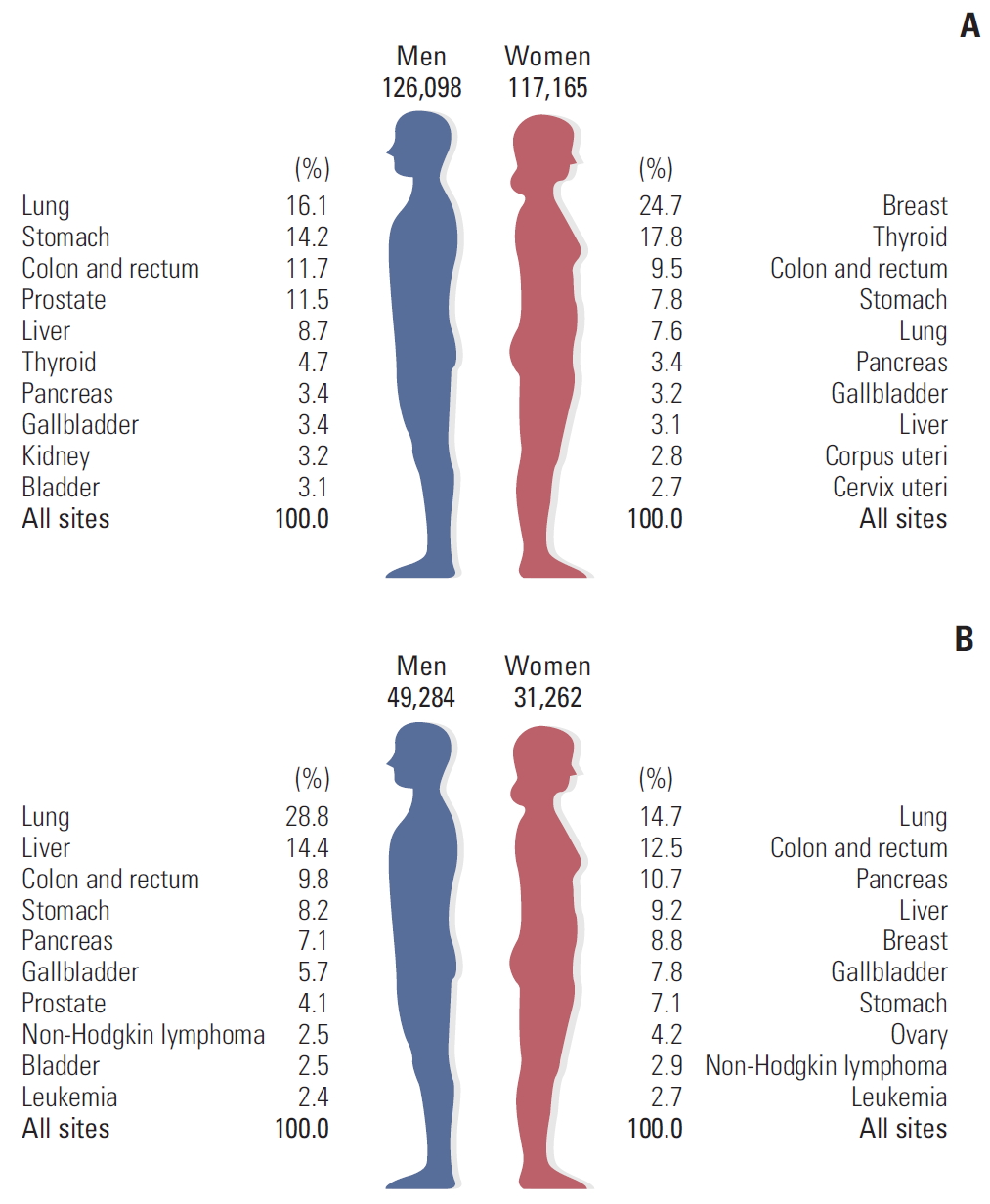
The 10 leading types of estimated new cancer cases and deaths by sex in 2020. (A) Estimated new cases. (B) Estimated deaths.
The projected CRs per 100,000 for all of the sites combined in 2020 are 487.5 and 450.9 in men and women, respectively (Table 2). The projected ASRs per 100,000 for all of the sites combined are 268.7 and 250.9 in men and women, respectively. In men, the five leading primary sites of cancer are expected to be the lung (CR, 78.6; ASR, 39.9), stomach (CR, 69.2; ASR, 37.2), colon and rectum (CR, 57.2; ASR, 30.5), prostate (CR, 56.3; ASR, 28.7), and liver (CR, 42.5; ASR, 22.9), accounting for 62.3% of all new cancer cases in 2020 (Fig. 1A). In women, the five leading primary sites are expected to be the breast (CR, 98.0; ASR, 61.0), thyroid (CR, 80.3; ASR, 57.5), colon and rectum (CR, 42.7; ASR, 18.3), stomach (CR, 35.1; ASR, 16.5), and lung (CR, 34.5; ASR, 15.2), accounting for 64.4% of all new cancer cases in 2020 (Fig. 1B).
The five most common cancer sites expected in 2020, according to sex and age groups, are shown in Table 3. Leukemia and thyroid cancer are expected to be the most common forms of cancer in both sexes for the 0-14 and 15-34 age groups, respectively. Stomach cancer is predicted to be the most prevalent cancer in men aged 35-64 years, while lung cancer is expected to be more frequent in men aged 65 years and above. Breast cancer is predicted to be the most common cancer in women aged 35-64 years, whereas colorectal cancer is expected to be the most prevalent in women aged 65 years and above. These projections indicate that the incidences of stomach, lung, liver, colorectal, and prostate cancers will increase gradually with age in men (Fig. 2A). In women, the age-specific incidence rates for stomach, colorectal, liver, lung, and cervical cancers denote an increasing trend with age; however, the incidences of breast and thyroid cancers in women are expected to level off after the age of 40 years (Fig. 2B).
2. Mortality
It is estimated that 80,546 cancer deaths will occur in Korea during 2020 (Table 1, Fig. 1). The projected CRs per 100,000 for all of the sites combined in 2020 for men and women are 190.5 and 120.3, respectively, whereas the projected ASRs per 100,000 for all of the sites combined for men and women are expected to be 98.0 and 48.2, respectively (Table 4). The predicted five leading cancer sites causing mortality in men are the lung (CR, 54.9; ASR, 27.2), liver (CR, 27.4; ASR, 14.6), colon and rectum (CR, 18.7; ASR, 9.6), stomach (CR, 15.7; ASR, 8.1), and pancreas (CR, 13.5; ASR, 7.0). During the same period, lung cancer (CR, 17.7; ASR, 6.3) is projected to be the leading cause of cancer death in women, followed by colon and rectal (CR, 15.1; ASR, 5.2), pancreatic (CR, 12.9; ASR, 4.8), liver (CR, 11.1; ASR, 4.0), and breast (CR, 10.6; ASR, 6.1) cancers.
The predicted age-specific mortality rates of the leading cause of cancer death in men and women in 2020 are shown in further detail in Fig. 3. According to age, Korean men and women aged at least 60 years are expected to have the highest mortality rates due to lung cancer.
Conclusion
A total of 243,263 new cancer cases and 80,546 cancer deaths are expected to occur in Korea during 2020. Lung cancer is predicted to be the most common type of cancer among men, followed by stomach, colorectal, prostate, and liver cancers. Lung, liver, colorectal, stomach, and pancreatic cancers are expected to be the most common causes of cancer deaths among men. In women, the five leading primary cancer sites are expected to be the breast, thyroid, colorectum, stomach, and lung, while lung, colorectal, pancreatic, liver, and breast cancers are projected to be the most common causes of cancer deaths.
Cancer is currently one of the foremost public health concerns in Korea. Although cancer incidence rates are anticipated to decrease slightly, the burden of most types of cancers will continue to grow with the increasing age of the population. The current projections of cancer incidence and mortality for 2020 represent an important resource for planning and evaluating cancer-control programs. As the estimates in this study are model-based, these results should be interpreted with caution.
Notes
Conflict of interest relevant to this article was not reported.
Acknowledgements
The authors would like to thank the tumor registrars (health information managers) of the KCCR-affiliated hospitals and non-KCCR-affiliated hospitals for their assistance with data collection, abstraction, and coding. Additionally, we acknowledge the cooperation of the National Health Insurance Service and Statistics Korea for their support with the data. This work was supported by the National Cancer Center research grant (No. 1910131).
